

Inca Paradox: Maybe the pre-Columbian civilization did have writing. - By Mark Adams. The greatest mystery of the Inca Empire was its strange economy. Hideouts or Sacred Spaces? Experts Baffled by Mysterious Underground Chambers - SPIEGEL ONLINE - News - International. Beate Greithanner, a dairy farmer, is barefoot as she walks up the lush meadows of the Doblberg, a mountain in Bavaria set against a backdrop of snow-capped Alpine peaks.
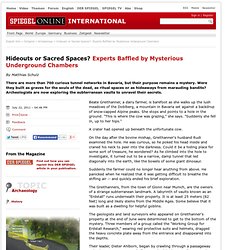
She stops and points to a hole in the ground. "This is where the cow was grazing," she says. "Suddenly she fell in, up to her hips. " A crater had opened up beneath the unfortunate cow. How the Potato Changed the World. The First Global Man. The last half century has not been kind to Christopher Columbus.
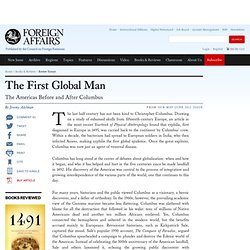
Drawing on a study of exhumed skulls from fifteenth-century Europe, an article in the most recent Yearbook of Physical Anthropology found that syphilis, first diagnosed in Europe in 1495, was carried back to the continent by Columbus' crew. Within a decade, the bacterium had spread to European soldiers in India, who then infected Asians, making syphilis the first global epidemic.
Once the great explorer, Columbus was now just an agent of venereal disease. Columbus has long stood at the center of debates about globalization: when and how it began, and who it has helped and hurt in the five centuries since he made landfall in 1492. Literary Review - Timothy Brook on Christopher Columbus and Vasco da Gama. Timothy Brook Raise the Holy Sail Columbus and the Quest for Jerusalem By Carol Delaney (Duckworth & Co 319pp £20)
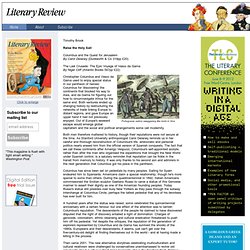
Ancient Rome. In its approximately 12 centuries of existence, Roman civilization shifted from a monarchy to a classical republic and then to an increasingly autocratic empire.

Through conquest and assimilation, it came to dominate Southern and Western Europe, Asia Minor, North Africa, and parts of Northern and Eastern Europe. Rome was preponderant throughout the Mediterranean region and was one of the most powerful entities of the ancient world. It is often grouped into "Classical Antiquity" together with ancient Greece, and their similar cultures and societies are known as the Greco-Roman world.
Ancient Roman society has contributed to modern government, law, politics, engineering, art, literature, architecture, technology, warfare, religion, language and society. A civilization highly developed for its time, Rome professionalized and expanded its military and created a system of government called res publica, the inspiration for modern republics[8][9][10] such as the United States and France. Ancient Roman History Timeline. Provides a chronological index of the history of Ancient Rome with extensive links to internet resources.

Emphasis is placed upon the use of primary source material, numismatics, and a focus upon the roles of women in ancient time. scroll down for the timeline Thank you for visiting! Children in the Roman Empire. Peter Thonemann Christian LaesCHILDREN IN THE ROMAN EMPIREOutsiders within350pp.

Cambridge University Press. £65.978 0 521 89746 4 Véronique Dasen and Thomas Späth, editorsCHILDREN, MEMORY, AND FAMILY IDENTITY IN ROMAN CULTURE392pp. Oxford University Press. £70 (US $125).978 0 19 958257 0 Published: 12 October 2011. Powered By Osteons: Line on the left, one cross each: Bioarchaeology of Crucifixion. As a researcher of the classical world, one of my favorite movies is Monty Python's Life of Brian.
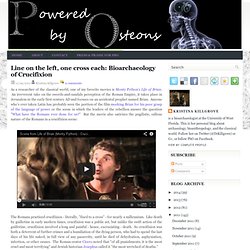
An irreverent take on the swords-and-sandals perception of the Roman Empire, it takes place in Jerusalem in the early first century AD and focuses on an accidental prophet named Brian. Anyone who's ever taken Latin has probably seen the portion of the film mocking Brian for his poor grasp of the language of power or the scene in which the leaders of the rebellion answer the question "What have the Romans ever done for us? " But the movie also satirizes the pugilistic, callous nature of the Romans in a crucifixion scene: The Romans practiced crucifixion - literally, "fixed to a cross" - for nearly a millennium. DengeDenge Online Magazine. Roman Senate. The Roman Senate. The Forum Romanum. Roman law. Ancient Roman Laws.
Roman Army. Alexander: How Great? by Mary Beard. Alexander the Great by Philip Freeman Simon and Schuster, 391 pp., $30.00 The Landmark Arrian: The Campaigns of Alexander edited by James Romm, translated from the Greek by Pamela Mensch Pantheon, 503 pp., $40.00.

THE MYTHS OF CHRISTIAN EUROPE. I wrote some notes a few months back on Pandaemonium on Rethinking the idea of ‘Christian Europe‘.
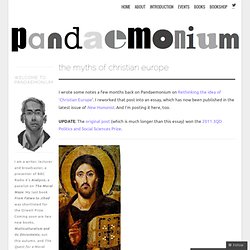
I reworked that post into an essay, which has now been published in the latest issue of New Humanist. And I’m posting it here, too. UPDATE: The original post (which is much longer than this essay) won the 2011 3QD Politics and Social Sciences Prize. Cullen Murphy - Inside the heresy files. On a hot autumn day in Rome not long ago, I crossed the vast expanse of St Peter’s Square, paused momentarily in the shade beneath a curving flank of Bernini’s colonnade and continued a little way beyond to a Swiss Guard standing impassively at a wrought-iron gate.
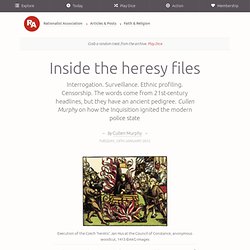
He examined my credentials, handed them back and saluted smartly. I hadn’t expected the gesture and almost returned the salute instinctively, but then realised it was intended for a cardinal waddling into the Vatican from behind me. Just inside the gate, at Piazza del Sant’Uffizio 11, stands a Renaissance palazzo with a ruddy ochre-and-cream complexion. Michelle Legro: Mercator Turns 500. Ah, to be at the center of the world! How Gerard Mercator changed history by creating the first useful map. By Michelle Legro. Social media in the 16th Century: How Luther went viral. Ancient Greece. Minoan civilization. Map of Minoan Crete The Minoan civilization was an Aegean Bronze Age civilization that arose on the island of Crete and flourished from approximately the 27th century BC to the 15th century BC.[1] It was rediscovered at the beginning of the 20th century through the work of British archaeologist Arthur Evans.
Will Durant referred to it as "the first link in the European chain. "[2] Ancient Greece - History, mythology, art, war, culture, society, and architecture. Ancient Greek Economy. Bronze Age storage jars at Knossos. Ancient Greece - History, mythology, art, war, culture, society, and architecture. Greek Slaves. Slave woman playing a kithara. You can tell she is a slave because she has short hair.
Food in Ancient Greece. The Greek diet consisted of foods that were easily raised in the rocky terrain of Greece’s landscape. Breakfast was eaten just after sunrise and consisted of bread dipped in wine. List of largest empires. An empire involves the extension of a state's sovereignty over external territories and variety of different ethnic groups. The term "empire" does not have a precise definition, but is generally applied to political entities that are considered to be especially large by the standards of their time and that have acquired a significant part of their territory by conquest.
Historical powers. The historical term "Great Nation",[3][4][5] distinguished aggregate of people inhabiting a particular country or territory, and "Great Empire",[6] considerable group of states or countries under a single supreme authority, are colloquial; use is seen in ordinary historical conversations (historical jargon). History[edit] Ancient powers[edit] The Ancients Civilizations that have shaped our planet. Ancient Civilisations Timeline. Mesoamerica. Mesoamerica and its cultural areas. Mayan Empire [2000 BC -1540 AD] The Mayan Calendar - The World Will Not End. Steep Uphill Climb to 2012: Messages from the Mayan Milieu ©- Copyright 2002 by Steven McFadden In early Autumn 2002, Carlos Barrios journeyed North from his home in Guatemala to the Eastern edge of the Four Corners.
The Mayan Calendar - Mayan Majix - Ian Xel Lungold - Mayan Astro. Aztec Empire [1428–1521 AD] Egyptian Empire [1570 - 1070 BC] AncientEgyptMap.jpg (JPEG Image, 841x1474 pixels) Mesopotamia. Map showing the extent of Mesopotamia Mesopotamia (from the Ancient Greek: Μεσοποταμία: "[land] between rivers"; Arabic: بلاد الرافدين (bilād al-rāfidayn); Syriac: ܒܝܬ ܢܗܪܝܢ (Beth Nahrain): "land of rivers") is a name for the area of the Tigris–Euphrates river system, corresponding to modern-day Iraq, Kuwait, the northeastern section of Syria and to a much lesser extent southeastern Turkey and smaller parts of southwestern Iran. History of Mesopotamia. Mesopotamian religion. Mesopotamia Dynasty list. Assyrian Empire [1920 - 609 BC] Babylonian Empire [1900 - 1600 BC] Akkadian Empire [2300-2200 BC] Achaemenid Empire [550 - 330 BC]
Ruins in Georgia mountains show evidence of Maya connection - National Architecture & Design. Median Empire [625 - 549 BC] Document Deep Dive: What Does the Magna Carta Really Say? Ancient history. Ottoman Web Site - FORSNET. Emperor Wang Mang: China's First Socialist? The Eunuch Admiral. Ancient Greeks.